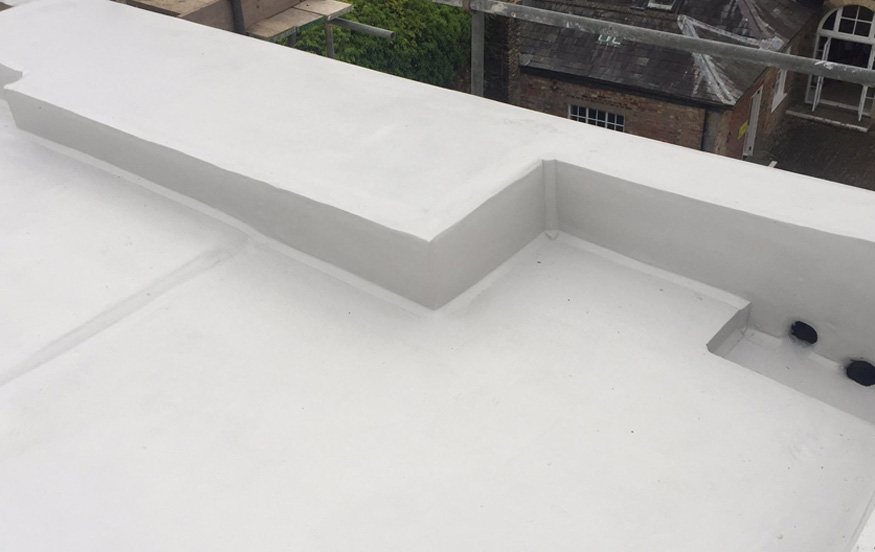Site safety is one of the primary considerations when it comes to building refurbishment, especially for contracts in sectors such as education and health.
Roofing works are typically subject to scrutiny from local authorities, building owners, Health and Safety Managers, regulatory bodies and other audiences, so roof refurbishment systems that pose any inherent risk during application are often disregarded on the basis of their tendency to increase insurance costs and slow projects down.
There has been trepidation amongst some building owners about sanctioning the use of naked flame at roof level, due to the risk of igniting an existing material during application. Although naked flame was used at the point of application for many years to apply many different types of waterproofing membranes, there is now increasing pressure from insurance companies, building owners and other parties regarding fire risk. Some have banned the use of naked flame altogether on roofs.
Furthermore, the Construction (Design and Management) Regulations 2015 place specific duties on building owners, specifiers and roofing contractors to take fire safety into account throughout a building’s life cycle, making sure that all people on site are protected if a fire does ever occur.
Collectively, these considerations have led to increased focus on the use of flame-free waterproofing systems which eradicate the need for a naked flame on the roof. By utilising flame-free roofing systems, fire risk from naked flame is eliminated and buildings can remain open and fully operational during the roof refurbishment work if required. This is particularly important for work carried out in schools, hospitals and health facilities, as there is minimal disruption to the school term or normal routines.
There are now many different roofing systems on the market that are applied with no need for naked flame, without compromising on performance properties, quality or aesthetics. One such roofing system is mastic asphalt. As mastic asphalt is laid in molten form, it is often confused with other types of waterproofing membrane that require naked flame or torch on application.
For major projects, mastic asphalt is usually taken to site by hot charge transporters or insulated dumpers direct from the manufacturer and taken to the point where it is needed for rapid installation – a major advantage for contracts with critical time constraints. For smaller projects, solid blocks are preheated in boilers placed at ground level. At no time is there any type of naked flame at the point of installation and because mastic asphalt is so highly flame resistant, there is little or no potential of fire risk.
One advantage of mastic asphalt is that it can be laid very swiftly. One 18 tonne hot charge delivery vehicle can supply sufficient mastic asphalt to cover 360m2of material to a depth of 20mm, which can be laid and finished in a matter of hours. This makes it particularly suitable for larger roofs where it can be applied over in-situ or precast concrete, timber or metal decking. Roofs can be quickly and efficiently waterproofed allowing other trades on site, often within hours.
Furthermore, the high mineral content of mastic asphalt renders it virtually incombustible. Mastic asphalt fulfils all the external fire resistance required for a roof covering and achieves the highest rating (AA) when tested in accordance with BS 476: Part 3. It has also been tested in accordance with draft European standards prEN1187-1 and prEN1187-2. No significant spread of flame was observed and no flame penetration occurred. Mastic asphalt systems also have Loss Prevention Certification Board (LPCB) accreditation for fire safety.
The flame-free application of mastic asphalt is a key selling point for many Mastic Asphalt Council (MAC) members and virtually all MAC contracting members are involved in projects in sectors such as education, retail and heritage applications where no naked flame is a prerequisite requirement on roofing projects,as well as many other mastic asphalt installations including paving, flooring, tanking and screeding.
For instance, MAC member Sussex Asphalte has completed a project at Farlington School, an independent day and boarding school in Horsham, West Sussex. Significant repairs were required to the masonry, slate and asphalt roofs. Over the years the roofs had a continual process of repairs and the internal fabric had started to deteriorate where the roof covering had failed. Various alternative roof covering options were considered and a new design using a polymer modified mastic asphalt roofing system was the chosen solution.
Mastic asphalt was identified as the most appropriate roof covering option on this project to provide the remediation required to the roofs and in light of the challenges the roof presented. Mastic asphalt provided a strong, seamless, robust and easy maintainable, long lasting roof covering.
Quickly and easily installed and flame-free at the point of installation, as well as being carbon zero, mastic asphalt allowed fast application within hours, avoiding extended curing times associated with other materials. It provides exceptional waterproofing, remaining impervious to water, as well as being vermin-proof and rot-proof.
As with many projects in the educational sector, time was of the essence and works needed to take place during the summer holiday period due to the scale of the work required. Work was started and completed in a timely manner, achieved to the satisfaction of the client, Clarke Roofing Southern, and the school.
This article featured in the October issue of RCi magazine. To read it in full please visit: https://www.rcimag.co.uk/digitaledition/rci-oct-2018/page_63.html

